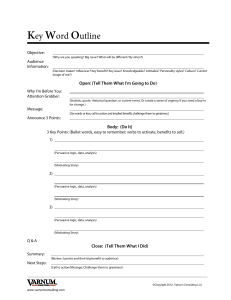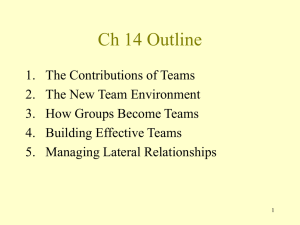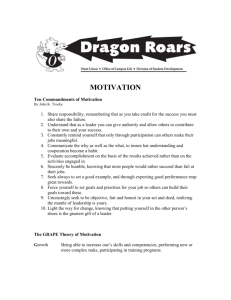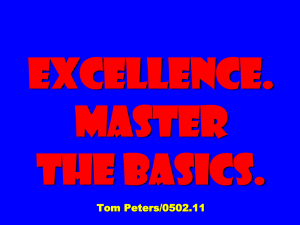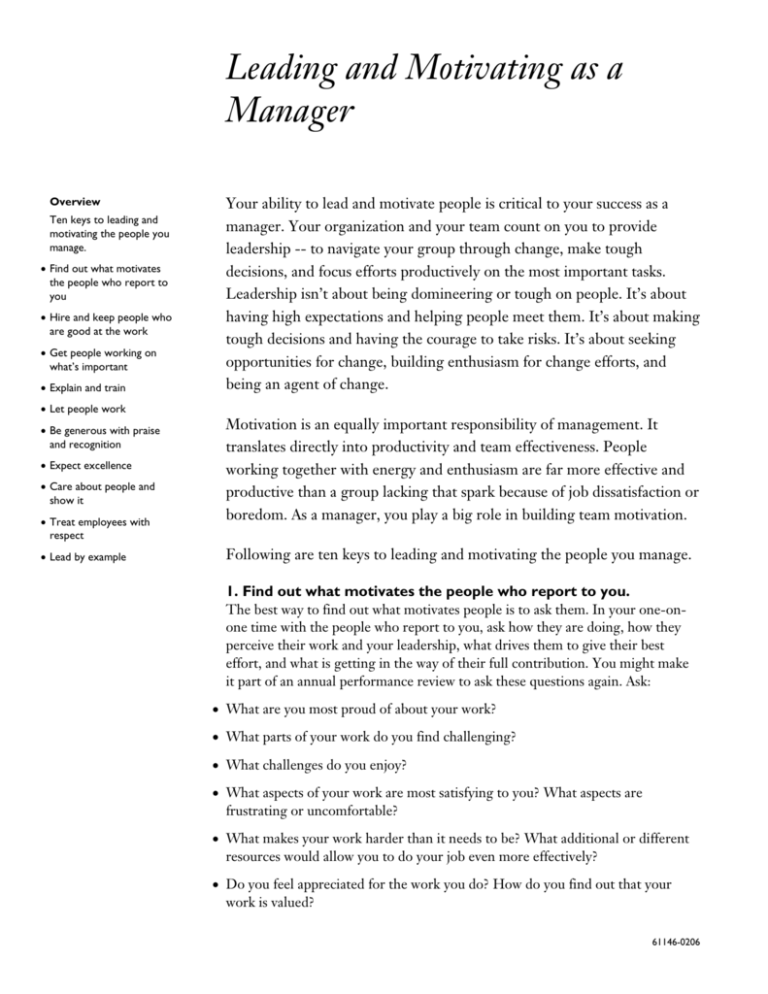
Leading and Motivating as a
Manager
Overview
Ten keys to leading and
motivating the people you
manage.
• Find out what motivates
the people who report to
you
• Hire and keep people who
are good at the work
• Get people working on
what’s important
• Explain and train
Your ability to lead and motivate people is critical to your success as a
manager. Your organization and your team count on you to provide
leadership -- to navigate your group through change, make tough
decisions, and focus efforts productively on the most important tasks.
Leadership isn’t about being domineering or tough on people. It’s about
having high expectations and helping people meet them. It’s about making
tough decisions and having the courage to take risks. It’s about seeking
opportunities for change, building enthusiasm for change efforts, and
being an agent of change.
• Let people work
• Be generous with praise
and recognition
• Expect excellence
• Care about people and
show it
• Treat employees with
respect
• Lead by example
Motivation is an equally important responsibility of management. It
translates directly into productivity and team effectiveness. People
working together with energy and enthusiasm are far more effective and
productive than a group lacking that spark because of job dissatisfaction or
boredom. As a manager, you play a big role in building team motivation.
Following are ten keys to leading and motivating the people you manage.
1. Find out what motivates the people who report to you.
The best way to find out what motivates people is to ask them. In your one-onone time with the people who report to you, ask how they are doing, how they
perceive their work and your leadership, what drives them to give their best
effort, and what is getting in the way of their full contribution. You might make
it part of an annual performance review to ask these questions again. Ask:
• What are you most proud of about your work?
• What parts of your work do you find challenging?
• What challenges do you enjoy?
• What aspects of your work are most satisfying to you? What aspects are
frustrating or uncomfortable?
• What makes your work harder than it needs to be? What additional or different
resources would allow you to do your job even more effectively?
• Do you feel appreciated for the work you do? How do you find out that your
work is valued?
61146-0206
2
z
Leading and Motivating as a Manager
• What kinds of work and what work situations have inspired you to give your full
energy and creativity? What work and what situations have made you less
enthusiastic?
• Do you have people you can count on when faced with difficult work challenges
or overload? Where do you get help and support when you need it?
The answers to these questions will give you insight into what motivates the
people who report to you. They will also give you a road map to the problems
you need to address as a manager and leader. Write down notes on these
conversations after you have them, and refer back to your notes from time to
time. Once employees give you such important information, they’ll expect you to
remember and act on it.
2. Hire and keep people who are good at the work.
Hire people who have the skills and abilities needed for the work. People whose
skills don’t fit the job’s requirements create inequity on a team, which can lead to
resentment from those who are doing their jobs well and frustration in the
person who is having trouble. Both emotions are motivation killers.
• Be careful and cautious in hiring. A great hire in a few weeks is better than a
mediocre hire now. Hiring mistakes are costly: Training time is wasted, your
strongest employees become frustrated, and firing an employee for poor
performance is traumatic for everyone. Ensure that references are checked
thoroughly.
• Don’t drag your feet when faced with a job-fit problem -- a person who does not have
the skills or ability to succeed in the job. A hiring mistake that isn’t corrected
quickly can demoralize the team, throwing you off track in reaching productivity
goals and even causing high-performing employees to leave. It is not an act of
kindness to keep a person in a job to which he or she is not suited, and taking
action only becomes harder on everyone as time passes.
3. Get people working on what’s important.
Focus your team’s efforts on the work that will make the biggest contribution to
the organization.
• Use goals as a tool to align work with the organization’s priorities.
• When you assign and prioritize work, take the time to explain why it’s important. Make
the link between the task and the team’s and organization’s goals. Remind people
of that link as the work proceeds. People work harder and smarter when they
understand how their work fits into the organization’s strategy. (If you don’t
understand the link yourself, ask your own manager to clarify.)
• Help your employees prioritize work to focus on the most important tasks. Work with
them to figure out how they spend their time. Be ruthless in determining how to
3
z
Leading and Motivating as a Manager
relieve them of unimportant and distracting work. Encourage them to ask why
they are doing tasks. If it’s not obvious, the work may no longer be important.
4. Explain and train.
• Make sure your employees have the skills and knowledge to do their work effectively. If
they don’t, teach them, give them the background knowledge they need, or
arrange for them to get the training they need.
• Plan ahead. Managers sometimes resort to “panic delegation” when they are
overloaded -- getting work off their own plate and onto someone else’s as quickly
as possible. That’s usually a bad idea, as the hand-off is often done in the middle
of a project and without the needed training and explaining. It’s a setup for
frustration and failure. Whenever possible, plan workloads weeks and months
into the future. Do your employees have the skills needed to complete the work?
If not, start training early. Bring employees into new projects at the planning
stage, not in the middle when your own overload hits the crisis point.
• Delegate with appropriate planning and training. Spend time every week (even if it’s
just a few minutes) teaching and sharing your knowledge and experience. You’ll
be a motivator, not a de-motivator. And you’ll attract and keep the best
employees.
5. Let people work.
Once you’ve assigned a task, explained why it’s important, and made sure your
employees have the skills and the tools they need to complete it to an agreed-on
standard, step back and let them do the work. Your job is to explain the “what”
and “why” of the task. Their job is to get the work done in the way they find
most efficient.
• Don’t meddle in, interfere with, or second-guess other people’s work. Be aware of what
your employees are doing by checking in on their progress toward the
expectations you’ve set. Coach them on their approach to the work. But let them
try their own approaches, too. Let them make mistakes, learn from them, and try
again. Be available to help clear away obstacles. Redirect them if they are off
course and at risk of failing to meet the expectations.
• When your employees make mistakes, have the courage to take the blame yourself.
Sometimes an employee really is at fault, but mistakes are often a team effort.
Your direction and supervision may have contributed to the problem. Admit to
the problem and take responsibility for fixing it. Then work with your employees
to identify what caused the problem and take steps to make sure it doesn’t
happen again.
• Let others make decisions as part of the work, and trust their judgment. Explain when
they need to ask questions and get approval and when you expect them to make
decisions themselves. If your employees come to you to make a decision they
4
z
Leading and Motivating as a Manager
have the information to make, gently push them to make it themselves. A good
response is: “I don’t know. What do you think?”
6. Be generous with praise and recognition.
People are driven by the need to feel good about themselves and what they are
doing. That’s why praise and recognition are such powerful motivators -whether it’s a “thank you” for a job well done or a substantial year-end bonus.
Don’t think there is nothing you can do because you don’t have the budget for
significant rewards. Small celebrations and regular praise for ongoing
accomplishments can actually fuel the most enduring enthusiasm for work.
Here are some ideas for recognizing and rewarding your employees:
• Look for and reward progress, not just the big accomplishments. Offer encouragement
along the way and praise for reaching milestones. Celebrate and recognize small
successes as well as big ones.
• Say “thank you” and “nice job” often. Don’t be sparing in your thanks and your
praise. There’s no risk of spoiling your employees. On the contrary, for most
employees, the better they feel about their abilities and their work, the better
work they’ll do.
• Catch people doing something right. Recognize it immediately with a compliment
and a thank you. In general, the closer the recognition comes to the activity, the
more powerful the message.
• Use your creativity to think of surprising, fun, and meaningful rewards. Brainstorm
with other managers, your human resources (HR) representative, or your team to
come up with new ideas. Gift certificates to movie theaters, bookstores, coffee
shops, or restaurants make memorable rewards. You may be able to reward
employees with informal time-off coupons or extended lunch hours. A special
recognition for a unique accomplishment can be more meaningful and
motivating than a “standard” reward.
• Be generous in giving credit to others. Remember that as a manager you get indirect
credit for everything your team does. If your team looks good, you look good. So
when your team does something worth bragging about, shine a spotlight on your
team members. Use your communications skills and your access to upper
management to see that they are recognized. A note from the senior vice
president to group members when a goal is reached or exceeded can have a
profound effect on morale.
7. Expect excellence.
Motivation and excellence go hand in hand. People will put their hearts into
work if they think the team and the organization are striving for excellence.
5
z
Leading and Motivating as a Manager
People want to be part of a world-class effort. Mediocre work, conversely, is
demoralizing for everyone.
• Expect excellence. Research has shown that expectations have a huge impact on
results. If you expect people to succeed, they are much more likely to do so.
Therefore, expect your employees to excel. Don’t tolerate mediocrity.
• Don’t tolerate negative attitudes or unproductive complaining. When worries,
complaints, and fears come to your attention, bring them out in the open. Raise
them at a team meeting. Be honest about what’s going on in the organization
that may underlie the worry. Figure out what aspect of the problem is within the
team’s control. Discuss what can be done to improve the situation and plan how
the team can do something about it. Move people from seeing themselves as
victims to understanding that they have the power to solve problems.
8. Care about people and show it.
• Listen to everyone. The strongest leaders make themselves available to ideas and
opinions from beyond their small circle of direct reports, no matter how tight
their schedules. They make a point of being available to people up and down the
organization. They put themselves in uncomfortable situations where they take
criticism and answer tough questions. They open themselves to ideas and
suggestions from the cleaning crew as well as the vice president of marketing.
• Make time to talk with your staff about things beyond the immediate tasks at hand. Use
a part of one-on-one meetings just to find out how all of your staff members are
doing, what’s going well in their work and what isn’t, what’s satisfying and what’s
frustrating, and (if they care to talk about it) what else is going on in their lives.
• Pay attention. Don’t open your mail, scan your e-mail, or look at papers on your
desk when someone is talking with you. Be present. Listen carefully. Ask
clarifying questions to make sure you understand what’s being said.
• Show that you care. Your employees are much more likely to care about work if
they know that you listen to and care about them.
9. Treat employees with respect.
Rudeness and a lack of respect for employees can undo all of the good you might
do by following the other advice in this chapter. Employees who don’t feel
respected are likely to shut down and contribute only the minimum effort to keep
their jobs.
• Create an environment where differences of opinion can be openly expressed.
• Demonstrate respect by listening and responding to your employees’ thoughts,
ideas, and concerns.
• Foster diversity by demonstrating respect for the unique qualities that each
individual brings to your team.
6
z
Leading and Motivating as a Manager
10. Lead by example.
Managers serve as models for their teams and for the organization. No matter
what you say, people notice and follow what you do. So if you want excellence
and enthusiasm from your team, model excellence and enthusiasm in everything
you do. Be energetic and your energy will be contagious. If you want your team
to focus on customers, focus on customers yourself. Lead and motivate by
example.
Work hard to model important and healthy values:
• Have fun. Laugh at yourself and bring humor to your work. Let work be playful
at times. Smile more often. Show how work can be fun and how working with
you and your team can be fun for customers.
• Make decisions and act in ways that are consistent with your principles. Make
courageous decisions. Do what is right. Organizations and employees count on
managers to act in principled ways.
• Set an example of a healthy work-life balance. Don’t hide the fact that you have
priorities outside work. Show that you can work hard and still be a good spouse
or partner, parent, friend, and family member, and a committed contributor to
your community. Show that you can get your work done and still make time for
exercise and a healthy lifestyle. Demonstrate by your own work habits that
success is measured more by excellent and efficient work toward clearly defined
goals than by long hours at work. Show that living a rich and balanced life is an
important and achievable goal, too.
Written with the help of Lynne Gaines and Adelaide Wilson. Ms. Gaines is Manager, Human
Resources, MMS/New England Journal of Medicine Publishing in Boston. She has an Advanced Human
Resources Certificate from Boston College Graduate School of Management/Bentley College and is the
author of HR articles and the former editor of The Levinson Letter. Ms. Wilson is licensed as a marriage
and family therapist and alcohol and drug counselor and is the Manager of Management Services at
Ceridian’s Work-Life and EAP Services.
© 2004, 2005 Ceridian Corporation. All rights reserved.

